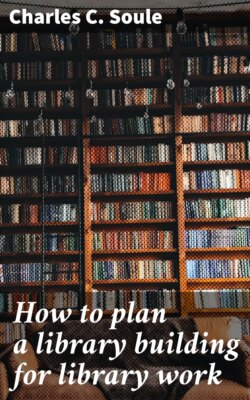Читать книгу How to plan a library building for library work - Charles C. Soule - Страница 29
На сайте Литреса книга снята с продажи.
Proprietary, Institutional
ОглавлениеProprietary. By these I mean what might be called literary clubs, owned in shares, and supported by dues, like Athenæums. Most of these combine some of the features of club libraries, and the reference and circulating functions of public libraries. Their constituency is smaller, however, more select, and usually has a higher degree of literary taste. In building, they will usually need rather more of the home or club atmosphere than other classes of libraries, and much less supervision. Here, for instance, the alcove and the window-nook might properly be used in reading rooms. The readers would be fewer, even in busy hours, and more homogeneous, so that a nervous man might pre-empt an alcove or a window seat and remain for hours comparatively undisturbed by either attendants or by other readers. Such societies will rarely build until they have a stable membership, many books and an accomplished librarian. From him the architect can learn the characteristics and habits of the members, and can begin planning by studying the features that will please them. As to the shelving of books, the administration and delivery, their problems will be much like other libraries, with perhaps more open access, especially to the new books for circulation.
The old-fashioned Mercantile Library, of which some survive in vigor, is similar in support, but more democratic in membership, and ought to be treated architecturally more like a public library, without children’s rooms or such social science features.
Institutional. Under this group I would include the libraries of endowed or charitable societies, such as Young Men’s Christian Associations.
If these are wealthy enough, they might have separate buildings or wings or stories for library use. Usually, however, they can only afford to set aside rooms or suites in buildings largely devoted to other purposes,—offices, class rooms, lectures, gymnasium. In such case, the library should be carefully planned to give it the best frontage and light.
Where there can be ample, and if possible separate elevator service, the upper floors, with some light through the roof, would probably offer the best opportunities. Rooms elsewhere in the building would give club facilities, so that feature of proprietary libraries might be omitted. The usual storage for books and good reference and light-reading-room facilities should be provided. If teaching is prominent in the plan of the institution, something like seminar rooms in colleges might be planned near the library, and private rooms for teachers and advanced students.
The administration of the library would probably be separate from that of other departments. The library might then be shut off from the rest of the building by sound-proof partitions, opening from a main corridor or from stairs and elevator, so as to be quiet and complete in itself.
